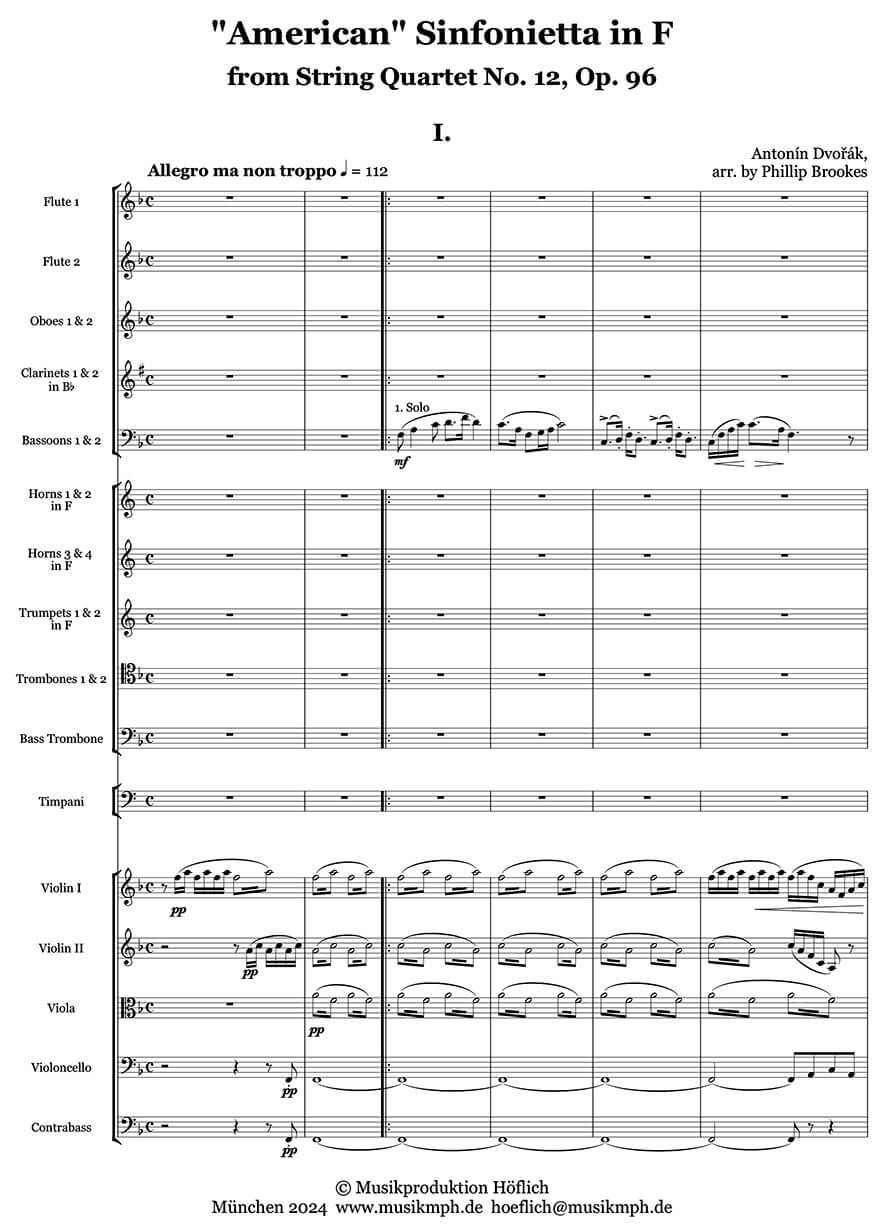‘American’ Sinfonietta, arr. from orchestra from String Quartet No. 12 in F, op. 96 by Phillip Brookes (first print)
Dvorák, Antonín / arr. Brookes, Phillip
34,00 €
Preface
Antonín Dvořák – ‘American’ Sinfonietta arr. for orchestra from String Quartet No. 12 in F, op. 96
(b. Nelahozaves (Mülhausen), 8 September 1841, – d. Prague, 1 May 1904,)
by
Phillip Brookes
Preface
In 1892 Dvořák accepted a generous offer to become Director of the new National Conservatory of Music in New York. It was not without problems and caused the composer much stress. For one thing, only two of his children accompanied him on the journey in September – 14-year-old Otilie (who would later marry Dvořák’s pupil, Josef Suk) and 9-year-old Antonín – their younger siblings could not follow until May 1893. The last page of the autograph score of the Symphony in E minor ‘From the New World’, completed on 31 May, has a marginal note in the composer’s hand recording that a telegram had just arrived to say that the children had just arrived safely from Southampton.
There were other stresses. One concerned money. Although he had been promised a salary of $15,000, he did not always receive it (it was eventually reduced to $6,000 because of an economic downturn). Then there were his views on ‘American’ music, which he felt should grow out of the folk idioms of the black and indigenous populations as much as anything else. This did not go down very well in 1890s America.
By the time he had finished the “New World Symphony” Dvořák was ready for a holiday. He was allowed one long vacation and he had expected to return to Bohemia, but since the rest of his family had only just arrived he accepted an offer from his secretary, Josef Kovařík, to join him in a small Czech community at Spillville, Iowa. Thus the Dvořák family made the long journey to the Mid-West – something the composer enjoyed because he was a lifelong train enthusiast. On the way they visited the World Exhibition in Chicago. Dvořák loved Spillville. He played the organ at mass each day and went on long walks and noted birdsong. He met members of the Kikapoo tribe, who visited regularly to sell herbs. And he composed some of his most popular works.
He began a string quartet almost immediately after arriving. Perhaps the best indication of how relieved he was to be away from New York lies in the timeline: sketch – 8-10 June; final score: 12-23 June. Dvořák was delighted – “Thanks be to the Lord God! I am satisfied – it went quickly”. Its premiere was in Boston on 1 January 1894, played by the Kneisel Quartet. This quartet, plus two other Spillville works, the String Quintet op. 97, and the Sonatina for Violin and Piano op. 100 (written for young Antonín to play with his sister Otilie at the piano) – and of course the “New World Symphony” – are perhaps the gems of his American legacy. One secret of their success lies in Dvořák’s use of pentatonic – or at least simplified – scales that give everything a ‘folky’ sound without actually belonging to a specific tradition. They allow us to hear African-American, Native American, and Irish influences without actually being so. It is a very winning style.
Such a style naturally gives rise to clear, simple harmonic and melodic structures that can adapt well to different instrumental groups. There have already been arrangements of the slow movement, sometimes called “Indian Lament” – at least one as early as before the First World War – as well as at least one version of the entire quartet for string orchestra. This new version is scored for a full orchestra of the size Dvořák regularly used, and seeks to be idiomatic without being a pastiche of Dvořák’s style. It opens with a rising pentatonic scale in a pithy first theme, played here on a bassoon. This gives rise to all the themes in the movement, including a fugato. The gem of the work is the slow movement, in which everything is derived from its opening theme. It conjures up Native American culture (with clear anticipation of many Hollywood scores) but it is also – surely – representative of Dvořák’s homesickness. The scherzo seems also influenced by the music of the Kikapoo visitors, though Dvořák does quote birdsong that he noted on his daily walks (fig.16 – it has been identified as the song of the scarlet tanager, commonly found in northern Iowa). The last movement – generally happy, but with passages of introspection – seems to be nothing less than a celebration of Dvořák’s beloved railways. It is almost a moto perpetuo representation of a train journey, though from the tenth bar of fig. 31 do we hear Dvořák playing the pipe organ in St. Wenceslas church in Spillville?
Dvořák was never able to repeat the innocent joys of the summer of 1893. The “New World Symphony” had its successful premiere at Carnegie Hall in December, making its composer nationally famous and beginning a year of controversy about “American” music and growing concerns about money. He returned briefly to Bohemia but was persuaded back to New York. But the second stay was less successful than the first, the pressures mounted and Dvořák returned to Bohemia for good in 1895 after he had completed the greatest of his American works, the Cello Concerto, op. 104. But it was less a celebration of American music than it was confirmation of his Czech roots.
Phillip Brookes, 2024
For performance material please contact Musikproduktion Höflich (www.musikmph.de), Munich.
Vorwort Deutsch lesen … > HERE
Score Data
| Sonderedition | The Phillip Brookes Collection |
|---|---|
| Genre | Orchester |
| Seiten | 136 |
| Format | 210 x 297 mm |
| Druck | Erstdruck |
| Aufführungsmaterial | vorhanden |
